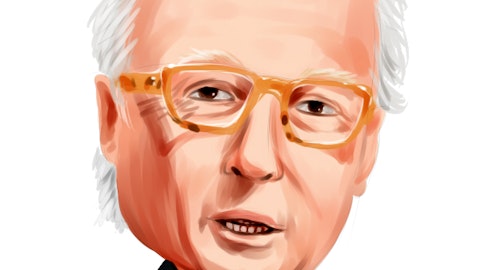Oracle Corporation (NASDAQ:ORCL) made our list of the ten technology stocks hedge funds were crazy about during the third quarter (see the full rankings) with 60 hedge funds and other notable investors reporting a position in the stock. Oracle has been in the news for its plan to accelerate its quarterly dividend payments, allowing investors to record them as income for 2012 (as it appears quite possible that the tax rate on dividends will rise substantially next year). Given the hedge fund interest it’s worth considering for longer-term investors as well.
The company’s most recent 10-Q (for the quarter ending in August 2012) showed a 2% decrease in revenue for the quarter compared to the same period in the previous fiscal year. Growth in the software business was offset by declines in hardware and services. With Oracle Corporation generally reducing costs- though investments in R&D were up 14%- net income increased at an 11% rate. As such the company seems to be doing well. Share count also decreased by 4%, and Oracle spent over $3 billion repurchasing shares last quarter. We’d take that as an indication that the company could continue to use buybacks to return cash to shareholders.
At a market capitalization of about $150 billion, Oracle Corporation trades at 16 times trailing earnings. However, as we’ve noted, the company has been growing nicely despite its size. Wall Street analysts expect that this growth will continue, with consensus for this fiscal year placing the stock at a current-year P/E multiple of only 12. That is setting a fairly rapid pace for growth in earnings per share, even with continued buybacks. Still, Oracle probably does not need to grow quite that fast to justify its current valuation.
We’ve already mentioned Oracle’s popularity in the hedge fund community. The Baupost Group was one major holder of Oracle stock, reporting a position of 13.5 million shares. Baupost is managed by Seth Klarman, a renowned value investor whose 1991 book Margin of Safety sells for $1,500 (check out Seth Klarman’s stock picks). Billionaire David Shaw’s D.E. Shaw nearly tripled its stake to a total of 6.8 million shares (find D.E. Shaw’s favorite stocks).
As an application software company focused on enterprise users, we would compare Oracle to Microsoft Corporation (NASDAQ:MSFT) and International Business Machines Corp. (NYSE:IBM). Market watchers are beginning to wonder how successful Microsoft’s new version of Windows will actually be; while some number of sales will occur no matter what, forward estimates seem to imply a bump to earnings from rapid adopters. The forward P/E is 8, but we can see the company underperforming analyst targets and so we would wait for more information about the reception of Microsoft’s new products. IBM, meanwhile, is being weighted down by its hardware business but managed to report flat earnings in the third quarter compared to the same period in 2011. Its trailing P/E is 14, a slight discount to Oracle that we think about accounts for its weaker business performance.
SAP AG (NYSE:SAP) and salesforce.com, inc. (NYSE:CRM) are two additional peers for Oracle. These companies are more priced for growth: SAP carries trailing and forward P/Es in the 20s while salesforce.com trades at 78 times forward earnings estimates. SAP’s business hasn’t been particularly well, with earnings falling despite rising revenue, and we think that we would avoid the stock. We do see some growth at salesforce.com- revenue increased 35% in the most recent fiscal quarter compared to a year earlier, but we’re skeptical that it can continue a high growth rate for a long enough time to match its price. We’d also note that 15% of the outstanding shares are held short, further suggesting that it may not be a good value.
Oracle (along with IBM) seems to be a better value than SAP or salesforce.com. In addition, we’re more confident that those two companies will maintain and grow their business going forward than we are with regards to Microsoft. Oracle is slightly more expensive than IBM on a P/E basis but has seen higher growth rates recently; investors should look at these companies in more detail but could easily pick one or both for a value portfolio.






